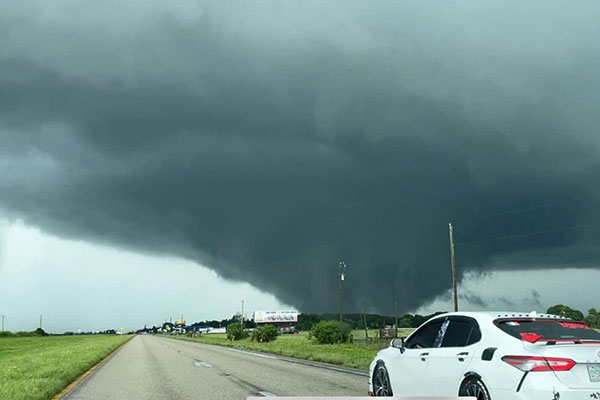Weathering the Storm of Misinformation on Social Media During Hurricane Season
Published: October 28, 2024
Social media resembles a double-edged sword when it comes to the weather. On one side, platforms like TikTok and X (formerly Twitter) offer real-time updates from trusted meteorological sources before, during and after severe weather events. On the other side, however, these same platforms have become inundated by misinformation and clickbait, especially during hurricane season. In recent years, the ratio of false or misleading online content to factual weather information has evidently increased, and so has the quantity of people who rely on social media for information on current events. It’s more important than ever to distinguish fact from fiction; the endless stream of online content has gotten very muddied, and we all need to learn how to sift through it.
Here are some strategies to help you avoid falling victim to weather-related clickbait and viral misinformation during hurricane season:
Follow the National Hurricane Center, Local News Outlets, and Meteorologists
The first step to help you avoid misinformation on social media during hurricane season is to follow the most reliable source for tropical cyclone information in the United States: The National Hurricane Center (NHC). The NHC is part of the National Oceanic and Atmospheric Administration (NOAA) and is staffed by various types of highly-educated and experienced scientists and forecasters who specialize in tropical cyclones. With access to resources and data that amateur hurricane enthusiasts do not have, the NHC provides the most accurate and up-to-date forecasts available for tropical weather systems. In addition, the NHC offers detailed information on potential storm tracks, intensities, and impacts— all of which are used by local emergency management officials to prepare their communities for an approaching tropical cyclone.
As a tropical depression, storm, or hurricane approaches, local news outlets typically rely on various weather products provided by NOAA’s NHC, Weather Prediction Center (WPC) and Storm Prediction Center (SPC) to provide comprehensive forecasts specific to your area, which may include excessive rainfall estimates and tornado risks in addition to storm surge and tropical storm or hurricane watches/warnings. Most local news outlets have verified social media accounts that you can follow to receive clear and localized guidance on what to expect and how to prepare, even if you are outside of the official NHC forecast cone. In addition to the NHC and your local news, it can be helpful to follow degreed meteorologists on social media. These professionals have formal education in atmospheric science and are often certified by respected organizations like the American Meteorological Society (AMS). Not only do these professional meteorologists provide reliable forecasts to their followers, but some often use their platform to debunk misinformation and correct viral clickbait social media posts that distort the present weather threat. By following professional meteorologists, you will not only receive reliable forecasts, but you may also gain the valuable context that clickbait posts attempt to skew.
Be Cautious with Viral Weather Images and Videos
The rise of content created by Artificial Intelligence adds a new layer of complexity to the spread of misinformation on social media. In the very real, devastating aftermath of Hurricane Helene across the southeastern U.S., AI-generated images of destruction circled around multiple social platforms gaining hundreds of likes, comments, and reposts. These false images, often designed to farm engagement from users, can mislead social media users to believe exaggerated or even completely fabricated conditions. Recent advancements in and accessibility to AI software that can create hyper-realistic images has made it difficult for people to differentiate between real and fake content. The widespread circulation of these fabricated images during hurricane season can be especially harmful if they undermine public trust in credible sources, confuse those in the damage path of a tropical cyclone, or instigate unnecessary panic in communities that are not expecting major impacts.
To identify AI-generated weather and disaster content during hurricane season, first verify its source: if it does not come from a trusted entity like the NHC, local or national authorities and media, or an accredited academic institution, be skeptical! You may also look for unrealistic details that AI-generated images tend to have, like unnatural lighting and shadows or inconsistencies in the landscape, infrastructure, people, and animals that appear distorted. When Hurricane Milton triggered a historical tornado outbreak across South to Central Florida earlier this month, AI-generated content creators were hard at work. A screenshot from an AI-generated video of a tornadic supercell appears in Figure 1; you may find it helpful to compare this image to the real, Hurricane Milton-associated tornado seen in Figure 2. Follow the hyperlink in Figure 1 and watch the first scene in the video to see the unrealistic movement of the clouds and the lack of wind in the surrounding landscape. Artificially created content such as this often fails to disclose its origins but receives tens of thousands of views, nonetheless.


In addition to AI-generated images, real videos of hurricane destruction are often recycled and falsely attributed to new storms each hurricane season. For example, videos that show storm surge inundation in Fort Myers, Florida during 2022’s Hurricane Ian frequently resurface online while linked to the current, or most recent, landfalling tropical cyclone. This combination of AI-generated content and recycled real footage of tropical cyclone and other severe weather impacts can create a perfect storm of misinformation during hurricane season. If you think a post might be falsely attributed to a different event, you can try Google’s reverse-search feature for images, which works for a screenshot of a video too. You may also find that some of these posts have already been fact-checked by social media users, as with X’s Community Notes feature (Figure 3).


